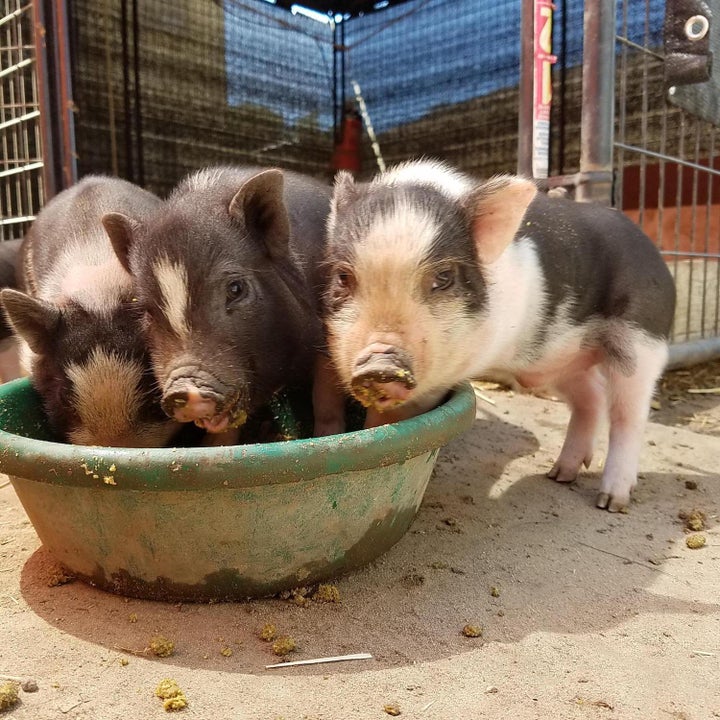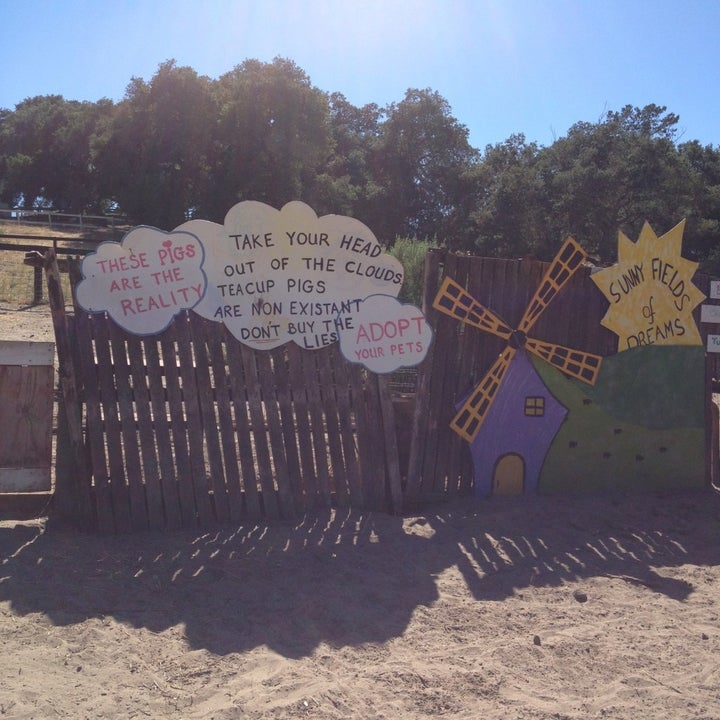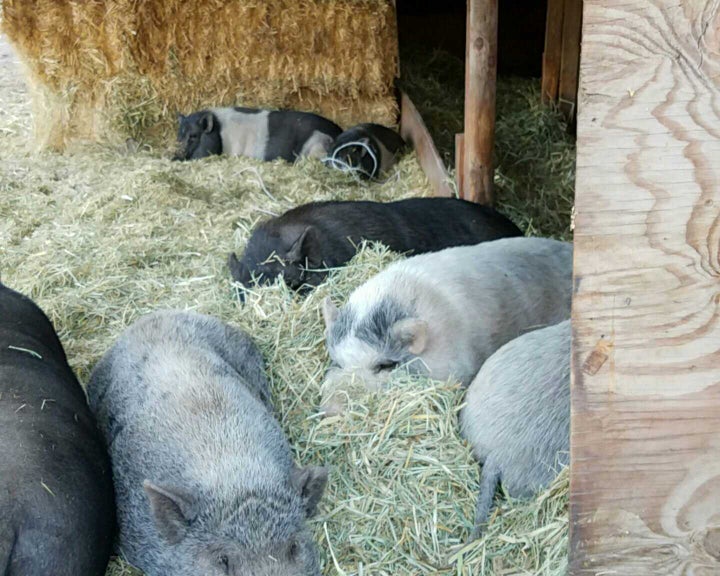Teacup pigs, micro pigs, pocket pigs, royal dandys, julianas - no matter the name, the pitch is always the same: Adorable pigs that grow up to be no bigger than a small dog. Breeders have been selling "micropigs" since the 1980s, and to hear them tell it, you cannot find a better pet. Smarter than dogs, cleaner than cats, they can be potty-trained, learn tricks and go "wee wee wee" all the way to your home. Unfortunately, teacup pigs are a big, fat lie.
Make no mistake, your teacup pig will be intelligent. A recent white paper from Farm Sanctuary and based on a 2015 study published in the International Journal of Comparative Psychology found that pigs have excellent long-term memories, are aces at solving mazes, have a sense of time (being able to anticipate future events), learn from humans and other animals and exhibit emotional empathy. They can most certainly be potty-trained, just like a cat, and if kept in ideal climatic conditions, they can also be very clean.
But they don’t stay small.

There are countless sites and social media groups that will dispute this. “Teacup pigs must be real,” goes the argument, “otherwise how do they fit them into those cute little teacups I see all over Instagram?” Those are baby pigs. And if you happen to meet an older pig that’s less than 40 pounds then you have just met an animal that is starving.
Consider this: Farm pigs can weigh up to 1,200 pounds (that’s more than half a ton). Wild hogs usually range between 450 and 700 pounds. New Zealand’s Kune Kune usually peak at 250 pounds. Compared to these porkers, the southeast Asian potbellied pig that is usually passed off as a teacup or Royal Dandy is indeed the runt of the litter. The smallest of these pigs bottom out at about 80 pounds, but they can - and often do - get much bigger.
Despite this fact, “teacup pigs” continue to be sold across America to unknowing owners who either starve them or watch in confusion as they grow well beyond their promised parameters. If the pig is lucky, it will end up at one of the 300 pig sanctuaries and rescues that have been established over the last few decades.
One such sanctuary is nestled in the hills of southern California’s Santa Barbara County. Founded in 1992 by Sue Parkinson, Li’l Orphan Hammies is a five-acre paradise for abandoned pigs. As of July, it is now home to more than 100 pigs, ranging in size from their newest four-pound piglets to the enormous 1,000-pound Valentine.
Recently, Planet Experts visited Li’l Orphan Hammies where I spoke to Sue Parkinson about running her sanctuary and dealing with the relentless profiteering of “teacup pig” breeders.
I arrived at the Li’l Orphan Hammies sanctuary a little after noon, the sweat already sticking to my back. A farmhand showed me around the place, which I found surprisingly quiet and deceptively empty. Sue had just taken in a high-profile haul of more than 50 pigs that had been abandoned in Stallion Springs, but there wasn’t a curly tail in sight.
Blame my urban ignorance. When Sue arrived a few minutes later with a recently spayed pig in her truck bed, the farm instantly came to life. A couple of dogs bounded from a dusty doorway and a cacophony of oinks rose like a Greek chorus. From under benches and bushes, from plastic igloos and dusty wallows, a handful of potbellied pigs rose to greet Ms. Parkinson.
It was a scorching California afternoon and the pigs had simply been doing what they do best: Napping. When Sue returned, they knew she would begin the exhaustive endeavor of feeding their squealing horde. By the time she was on her feet and moving, a score of porkers was milling around the yard, their coarse hairs rubbing against my knees, their muddy snouts occasionally pointing skyward to determine if I was hiding snacks or just in their way.
Sue simultaneously carried on a conversation with me and her pigs as she dashed from one station to another, refilling water bowls and preparing fresh feed. I quickly understood that keeping up with the sanctuary founder would be difficult on a normal day, and this was anything but.
Weeks before I visited the farm, police discovered more than 50 pigs on an abandoned property in Kern County. The animals were malnourished and underweight and without access to running water. Animal Control seized the animals and divided them among the Bakersfield and Mojave shelters, then put them on a routine 10-day sale/adoption hold while they waited for the owner to come forward. She did not.
Sue was acquainted with the owner of the pigs and their abandonment was something she’d been dreading for a long time. It’s impossible for her to ignore one pig in need, let alone half a hundred.
“I drove out there because I couldn’t get any straight information on the phone,” she explained. “I had 65 pigs before I took on this rescue and I wasn’t taking in more pigs. But I went and saw them and the conditions they were living in and I said, how can you take one and not the other? They were being euthanized on the 18th, that Thursday.”
Not all the pigs would be euthanized, though. Several were pregnant, and the piglets could be sold for as little as $11 when Animal Control put them up for adoption. To see young pigs placed in the hands of ignorant owners is not something Sue will accept. Her voice rises when she talks about it; the anger of two decades blazes in her eyes. She’s taken in too many pigs and seen the aftermath of too much abuse. This isn’t a hobby for her, it’s not cute.

The sign inside the Li’l Orphan Hammies sanctuary.
“They had so many people wanting them,” she said. “These people turn around and sell the babies. Then they’re in the hands of the wrong people. Who’s going to pay $500 for a spay and neuter? They would have created a nightmare.”
But Sue’s ire wasn’t reserved for profiteers alone. Even fellow animal lovers were ignoring the big picture. “Everyone who has pigs wants to help, but they were focusing on the pregnant pigs. Why isn’t anyone talking about the male pigs? They don’t have a right to live, you just want the babies? I was like, ‘screw you guys.’ I was livid.”
Sue did not intend to take them all, but when she saw the pigs herself, “I looked at my friend and I said, ‘How do I take one?’”So she didn’t take one. She took them all. They’re doing pretty well.
And so are the piglets.
Twenty-four years ago, Sue bought her first teacup pig.
“There was a breeder here and she was selling them for thousands,” she said. Then, as now, the breeder told her that the pig would remain teeny tiny as long as she fed it its special diet. “It was the same story 25 years ago. Nothing’s changed. It’s the same line, they’ve just gotten creative. When I bought mine they were calling them royal dandys and julianas. It’s ‘poodle pigs’ now.”
At the time, all Sue knew about pigs she learned from two neighbors in the valley. “We did not have the internet like we do today,” she said ruefully.
Many of the potbellied pigs that are passed off as teacup pigs today can be traced to the importation of the “Con Line” (named for Keith Connell) from Canada in the 1980s. These pigs typically ranged in size between 130 and 170 pounds - slim by pig standards. Two other lines of pigs, known as the “Lea Line” and the “Royal Line,” later followed. According to the Pig Placement Network, these three lines “represent most of the foundation stock found in America today.”
But how do breeders pass off these potbellies as smaller-than-average pigs? By breeding runts over several generations and lying to their customers. It’s possible to select for smaller pigs, but pigs can breed so fast that a line will often be inbred several times over. This leads to health problems and a surplus of big, unwanted pigs.
To feed their customers the lie, breeders can easily point to a piglet’s parents to show how tiny they are. As Melissa Susko, executive director of PIGS Animal Sanctuary, explained to the Dodo, this works because pigs can breed as early as six-weeks-old.
Sue can attest to that. At just a few days old, some of her piglets were already trying to mount their sow.
In her interview with the Dodo, Susko states flatly that teacup pigs do not exist. “Miniature pigs are mini compared to a domestic farm pig that can reach 600-plus pounds,” she said. “So-called teacups are actually potbellied pigs who are either underfed to stunt their growth or who are sold under false pretenses.”

“That’s what’s going to sell,” said Sue, “because you’re not going to buy the reality of what a pig is. If you look at [breeders’] websites, they’ve got little hats on, they’re next to a shoe, a Pepsi bottle. Their ‘pixie pigs’ are sitting under sunflowers. People buy the lie.”
I felt stupid asking Sue my next question, afraid to expose my own naiveté, but the magnitude of the lie seemed too big and too obvious to perpetuate. Why go to all the trouble?
The answer, as you probably guessed, is money. Mini pigs sell for thousands of dollars. “Breeders are out for the buck, and they're going to be your friend because they want you to buy from them. It's all a game.” Sue laughed in disgust. “They know they're going to be able to sit on their computers all day, let their pigs screw, make babies, and sell them. That's all they are.”
Sue lives, works and sometimes naps with her pigs, so seeing them boiled down to profit or even food is painful to her. They’re intelligent animals caught in a vicious industry that has been exploiting them for more than a quarter of a century.“
Breeders are telling people they’re apartment pets. They’re not an indoor pet,” she said. “It’s cruel.”
I asked Sue if that meant pigs couldn’t live in an apartment, but she clarified that pigs do fine in an apartment - if that’s all they know. “If you keep them in the house, they don't know that outdoors is a thing. But if you have a child, are you going to confine your child inside all their life? They need sunlight.”
And confining a pig indoors is asking for trouble. Some dogs shouldn’t be left alone in a house, but most pigs can’t be left alone at all.
“You feed them food because it’s just so much fun to watch them eat,” said Sue. “It’s cute. But then you make the mistake - you open the refrigerator door and say, ‘Oh, have a strawberry.’ But if you’re not there they think, ‘Oh, I’ll just open the door myself next time.’ Same with the pantry, ‘Oh, I’m bored…’”
That’s what Sue discovered with her first pig. She overfed him and he quickly ballooned. That’s what pigs do. And as they get older, tusks can also be a problem.“If he was upstairs and got bored he’d take his tusks and just take the drywall off.”
Some breeders will tell their customers that they remove the tusks when the piglets are young. This is another lie. You can’t find a tusk on a pig until it’s about two-years-old and the tusks don’t start to peek through their lips until they’re three. When that happens, owners will sometimes take bolt cutters to the tusks, which endangers the health of the pig. The tusk’s root is located deep in the pig’s jaw, and damaging it carries the risk of serious infection. But there are few professionals owners can turn to for advice. Vets don’t typically see pigs.
Fortunately for her pigs, Sue has a strong community of healthcare professionals to rely on. Unfortunately, that doesn’t make spaying and neutering any cheaper. Spaying a female pig costs half a grand.
When I visited Sue’s farm, she had just spayed several of her new pigs. Several others were already far along in their pregnancies. Two of the Stallion Springs rescues had recently given birth, and she counted the piglets as she showed me how to hold them. I failed to do so in any position that did not make them squeal.
“If you hold them like a dog, underneath, they’re going to squeal,” she reassured me. But it’s important to get them used to human touch early on. Dogs bond with humans by instinct, but pigs have to be socialized to it.
It’s telling the hard truths about owning a pig that has made Sue the scourge of piggy messageboards across the web.
“[New owners] buy them from breeders and they're not educated. You get a pig from me, I'm going to tell you everything negative, you're going to learn everything, and you're going to spend time here and you're going to know what to do. You're not going to be asking stupid questions.”
Wanting a cute little pig for a pet is not wrong, Sue reiterated, but there is a big difference between wanting a fantasy piglet that won’t force you to change your life and caring for a large, intelligent - and often willful - living creature.
Pigs are abandoned all the time because owners can’t face up to that reality. “It’s an epidemic,” said Sue. “It’s that bad.”
You want to piss off Sue Parkinson? Ask her about the Chase commercial where the yuppie couple take their pig for a walk.
Every time a cute little pig shows up in the media, Sue grits her teeth and prepares for the worst. Paris Hilton, to her credit, didn’t give up her teacup pig when it ballooned into a mama hog, but the young girls who idolize her are probably not hotel heiresses. They don’t have the money or the resources to care for their pocket pig when it outgrows their pocket.
It’s the same for George Clooney and his pig Max. Sue didn’t question Mr. Clooney’s devotion to his pig, but an actor’s career requires them to travel around the world. That’s not fair to the pig, said Sue. And pairing pigs with high-profile stars just encourages breeders to keep breeding. “Thank you, George,” lamented Sue.
That sounds harsh, and it’s supposed to. Sue has been operating her non-profit for 19 years and, with the exception of her very first pig, every single one of her “hammies” is a rescue.

Most of Sue’s “patio pigs” - the pigs who roam free around the farm - come from college kids “who swear they’re going to take the pigs back, or from people who had to move and couldn’t or wouldn’t take their pigs. Those pigs are people friendly, and they’re good for education.”
Some of Sue’s older pigs, the ones visitors are less interested in adopting, come from unknown backgrounds. They’re discovered on country roads or left abandoned on properties like the one in Stallion Springs. “People are not beating down your door to adopt an older adult pig,” said Sue. “But those are the ones my heart goes out to. They’re such creatures of habit. They don’t like change.”
A percentage of Sue’s pigs do find new homes, but for most of them, Li’l Orphan Hammies is the last stop.
“Every time I take in a pig I need to know that I have the money on my own for the life of that pig,” said Sue. It hasn’t always been easy. She used to work three jobs and today, when most women her age are thinking about retirement, she still works nights. And while Sue does have a handful of plucky volunteers, her youngest is 70-years-old.
I asked Sue if she thought about bringing on some younger farmhands but she said there were few young people in the valley willing to shovel shit all day - which is largely what the volunteers do. “I don’t have time to babysit them,” said Sue.
But she doesn’t mind that much. Her pigs are her family.
When the sun goes down the pigs go down with it. “They usually sleep anytime they’re not eating. Younger ones root and are a little more active, but the older ones are sleepers.” And when the farm is quiet, Sue drives to work. She does audits and accounting from 8pm to 4am.
For more information on Li’l Orphan Hammies, visit their website and Facebook page. If you’d like to help out the farm’s latest rescues, head to their GoFundMe page and make a donation.
This article originally appeared on Planet Experts.
